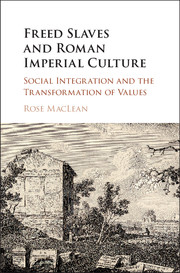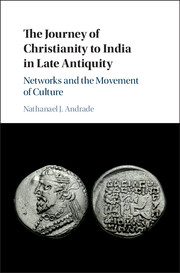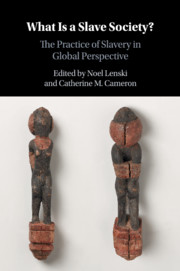Refine search
Actions for selected content:
23990 results in Ancient history

Freed Slaves and Roman Imperial Culture
- Social Integration and the Transformation of Values
-
- Published online:
- 09 May 2018
- Print publication:
- 17 May 2018

Institutions and Ideology in Republican Rome
- Speech, Audience and Decision
-
- Published online:
- 08 May 2018
- Print publication:
- 17 May 2018

The Journey of Christianity to India in Late Antiquity
- Networks and the Movement of Culture
-
- Published online:
- 03 May 2018
- Print publication:
- 19 April 2018
2 - Early China
-
- Book:
- Empires of Ancient Eurasia
- Published online:
- 20 April 2018
- Print publication:
- 03 May 2018, pp 42-67
-
- Chapter
- Export citation
8 - Maritime Routes of the First Silk Roads Era
-
- Book:
- Empires of Ancient Eurasia
- Published online:
- 20 April 2018
- Print publication:
- 03 May 2018, pp 204-237
-
- Chapter
- Export citation
6 - The Parthian Empire and the Silk Roads
-
- Book:
- Empires of Ancient Eurasia
- Published online:
- 20 April 2018
- Print publication:
- 03 May 2018, pp 148-175
-
- Chapter
- Export citation
3 - Zhang Qian and Han Expansion into Central Asia
-
- Book:
- Empires of Ancient Eurasia
- Published online:
- 20 April 2018
- Print publication:
- 03 May 2018, pp 68-90
-
- Chapter
- Export citation
Index
-
- Book:
- Empires of Ancient Eurasia
- Published online:
- 20 April 2018
- Print publication:
- 03 May 2018, pp 298-304
-
- Chapter
- Export citation
Conclusion
-
- Book:
- Empires of Ancient Eurasia
- Published online:
- 20 April 2018
- Print publication:
- 03 May 2018, pp 276-283
-
- Chapter
- Export citation
5 - The Roman Empire and the Western Silk Roads
-
- Book:
- Empires of Ancient Eurasia
- Published online:
- 20 April 2018
- Print publication:
- 03 May 2018, pp 119-147
-
- Chapter
- Export citation
Introduction
-
- Book:
- Empires of Ancient Eurasia
- Published online:
- 20 April 2018
- Print publication:
- 03 May 2018, pp 1-15
-
- Chapter
- Export citation
Contents
-
- Book:
- Empires of Ancient Eurasia
- Published online:
- 20 April 2018
- Print publication:
- 03 May 2018, pp v-viii
-
- Chapter
- Export citation
9 - Collapse of Empires and the Decline of the First Silk Roads Era
-
- Book:
- Empires of Ancient Eurasia
- Published online:
- 20 April 2018
- Print publication:
- 03 May 2018, pp 238-275
-
- Chapter
- Export citation
4 - The Early Han Dynasty and the Eastern Silk Roads
-
- Book:
- Empires of Ancient Eurasia
- Published online:
- 20 April 2018
- Print publication:
- 03 May 2018, pp 91-118
-
- Chapter
- Export citation
1 - Pastoral Nomads and the Empires of the Steppe
-
- Book:
- Empires of Ancient Eurasia
- Published online:
- 20 April 2018
- Print publication:
- 03 May 2018, pp 16-41
-
- Chapter
- Export citation
Figures and Maps
-
- Book:
- Empires of Ancient Eurasia
- Published online:
- 20 April 2018
- Print publication:
- 03 May 2018, pp ix-xii
-
- Chapter
- Export citation
7 - The Kushan Empire
-
- Book:
- Empires of Ancient Eurasia
- Published online:
- 20 April 2018
- Print publication:
- 03 May 2018, pp 176-203
-
- Chapter
- Export citation
Copyright page
-
- Book:
- Empires of Ancient Eurasia
- Published online:
- 20 April 2018
- Print publication:
- 03 May 2018, pp iv-iv
-
- Chapter
- Export citation
Bibliography
-
- Book:
- Empires of Ancient Eurasia
- Published online:
- 20 April 2018
- Print publication:
- 03 May 2018, pp 284-297
-
- Chapter
- Export citation

What Is a Slave Society?
- The Practice of Slavery in Global Perspective
-
- Published online:
- 26 April 2018
- Print publication:
- 10 May 2018
